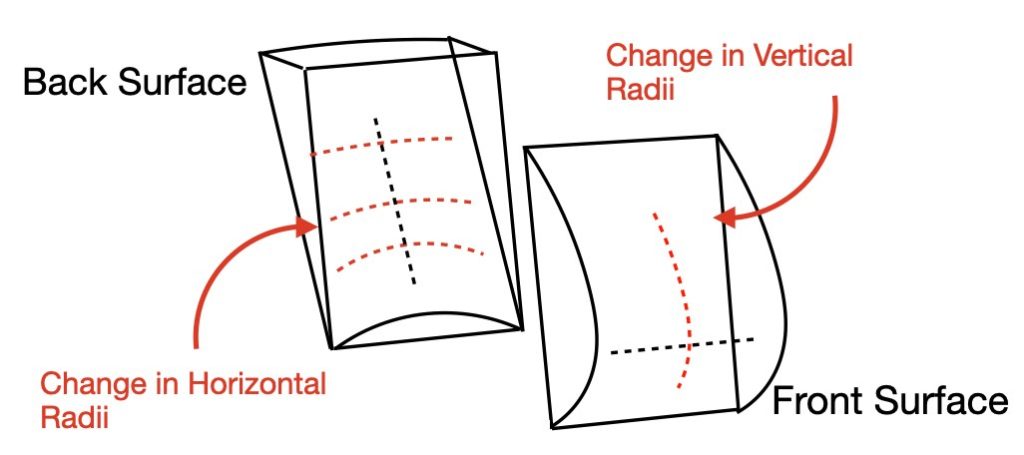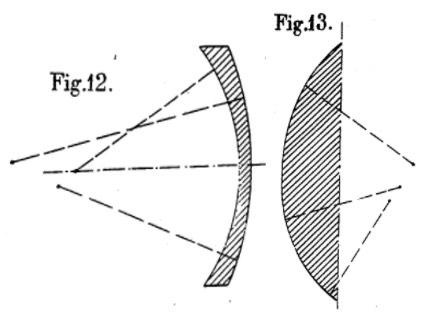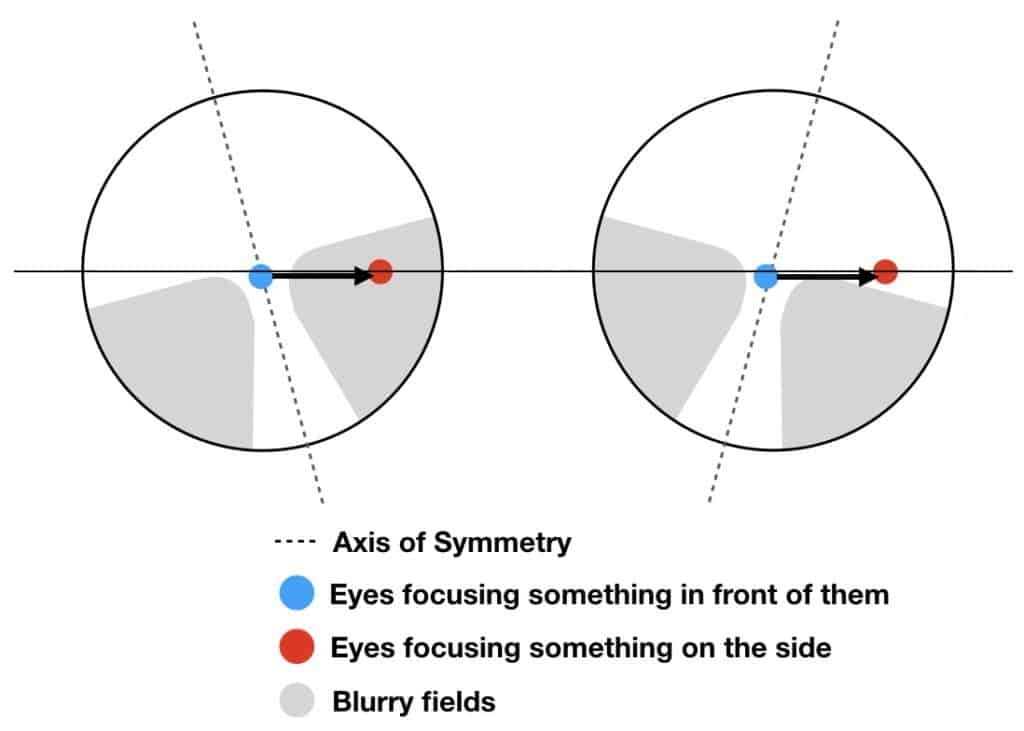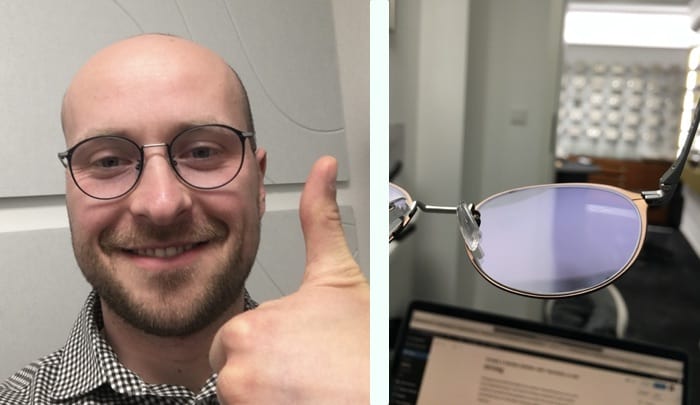In this article, you will find pieces of information about the history of progressive lenses. In addition to our descriptions, you will find linked patents to the inventions of progressive lenses which lead to the great and very fine-tuned versions of progressive lenses from today.
In 1907 Owen Ave patented a dual surface progressive lens design. As the progressive lenses from today, it had a progressively increasing lens power but the special shape of the lens made to hard to manufacture at that time.

It was a combination of two crossed sections of a cylinder with altered radii in the lower part of the lens to achieve the increase in lens power. The shape of this type of progressive lens design was vastly different from the one’s today.
Henry Orford patented the first progressive lenses in 1909 in the US we came a long way to the progressive lenses from today. Because this was not the patent that led to the famous progressive lenses we all know and can buy in every optical shop near you.
The reason was the manufacturing limitations and the lack of the advent of computer‐numerically‐controlled grinding techniques. The mass production of complex progressive lens surfaces lacked the symmetry of a surface met with insurmountable challenges.

Another patent that failed due to the needed grinding techniques was the invention from Georges Poullain and Julien Cornet in 1911. This patent already describes a design with an umbilical main meridian, with stabilized far and near vision zones. But the breakthrough came decades later meanwhile the manufacturing processes got continued to progress.
Who invented the progressive lenses we use today?
The engineer Bernard Maitenaz invented progressive lenses in 1959. He joined SL in 1948. Bernard Maitenanz patented a lens design with progressively increasing lens powers in the lower half of the lens.

It was a truly revolutionary concept in this time and allowed presbyopia for a more natural correction in distance vision and while reading. Those lenses were made out of glass at the time and enabled the manufacturer SL that became Essel in 1962 to produce glasses for presbyopia without a visible line.
Many patents were influenced by Bernard Maitenaz. Of course, innovation was driven by the whole team at Essel. In 1976 the first progressive lens was released made out of plastic. The Varilux Orma. The material was already in the market since 1959 and was called Orma 1000. It was the work by the team around René Grandperret which lead to this innovation.
Having achieved this breakthrough in the manufacturing processes is definitely an engineering feat. But this first progressive lens design (Varilux 1) lacked a lot of features today’s progressive lenses have. With the increasing capacities of computing power and manufacturing processes, progressive lenses got fine-tuned and surface astigmatism which leads to blur could be reduced.

At that time the lenses had to be rotated into the desired position to match the reading zones to the position the wearer was looking through the lens. This of course is not necessary today anymore. This technology was adapting to the customer’s needs with every new generation of lens designs and refinement in the manufacturing processes.
This was a huge task in a time when computing was still very mechanical with punch cards. The models Varilux 1 and the successor Varilux 2 were industry-leading products who got rebranded under the name of other well-known suppliers of ophthalmic lenses.
Freeform progressive lenses
It was the work of the ambitious mathematician Gerhard Further who worked for Carl Zeiss who patented to the Free Form technology in 1981 (EP0039497). Until than Carl Zeiss used the Varilux technology under their brand name Gradal. But the in house developed patent gave them the edge in terms of the possibility to personalize the lens design for the wearer later in the development. This tech was branded under the name Gradal HS. Today nearly every progressive lens design is based on this technology.

Over the generations of progressive lens designs more and more parameters influenced the lens design and set to a more natural visual experience for the wearer. Werner Koeppen a physicist and his team that was involved in the development of the Varilux Comfort design from the 1960 – 1990s led less required eye movements and a bigger field of view compared to the precursor lens designs.
This step in the development of progressive lenses was still a standardized design. This means it was not possible to take into account how the frame sits in the face of the wearer or a different pantoscopic tilt. In such a approach the portion for reading in the lens design is placed in the same way for a person with a extremely wide pupillary distance as well a very small pupillary distance.
Custom made progressive lenses
One of the major benefits for the wearer of progressive lenses are the custom features to fine tune the lens zones individually for the person and the chosen frame. Those parameters are:
- reading distance (near and intermediate)
- vertex distance
- pantoscopic tilt
- wrap angle
- form factor
- options for lens designs (focus on near, mid or distance part)
- variable inset
All those factors help to place the reading zones in the best spot possible to achieve the biggest field of view and less distortion and blur in the periphery.
It was the work in 1996 from Dr. Albrecht Hof and Adalbert Hanssen which made it possible to take those custom parameters into account. In addition to the individual fitting setup of the wearer, the change in power development, and the progressive part of the lens was placed on the back surface. This achievement led to bigger fields of view too.

The result of this milestone was the Gradal Individual. This progressive lens design has set a new standard in terms of modern progressive lenses. Slightly after Zeiss came Rodenstock with their approach of progressive lens customization to the market.
Currently, the Rodenstock group is the only manufacturer who’s is able to produce different power in astigmatism throughout the lens corridor. All the inventions were driven by a lot of people who are not mentioned in this article to keep it short. So keep in mind that this article just can hold so much information.
Nothing is mentioned for example about the work of Dieter Kalder who devoted his work life to progressive lenses and the optimization in the processes for the measurements of those high tech lenses.
We as passionate opticians stay up to date by watching the market changes in the world of progressive lenses and are excited about the upcoming developments. You will find out more in this blog.
I wish you a great day.
